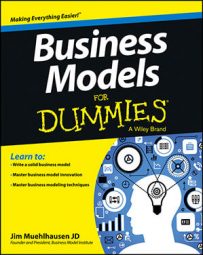You don’t need a unique offering in order to have a business model. If, however, you want to have the most successful model possible, you want to offer customers something they can’t get somewhere else.
This uniqueness may be only one thing, such as the sole gas station on a particular corner, or it may be a combination of product and service features, such as those in a Lexus automobile. All the differences of your offer versus your competitors’ equate to your unique value proposition.
Nearly every market is crowded with an abundance of offerings and competition, yet many of these same markets have one company that dominates. How do these companies rise above so much competition and do it profitably?
These stellar companies — like Apple, Virgin Airways, Amazon, Discovery Networks, and Priceline — have captured large market shares by offering customers something they simply can’t buy somewhere else. Traditionally, customers not only choose these differentiated offerings over those of competitors, but also pay a premium price for them.
Examples of differentiated offerings include the following:
Morton salt is differentiated by tradition, reputation, and brand. Morton was the first company to offer salt in convenient cylindrical containers as well as the first to add iodine to salt. This addition may not seem like a big deal, but it solved a national health crisis. Thyroid-related growths called goiters were common, and small amounts of iodine in the diet prevented them.
Morton established a dominant market share in the 1920s and still maintains it. More importantly, this market-leading brand sells for two to three times more than generic salt, which is virtually identical.
Sony televisions sell for nearly double the cheapest brands on the market. Sony’s reputation for quality and cutting-edge features allows the company to command a large market share and premium pricing.
Disney theme parks are 95 percent the same as hundreds of other theme parks. All theme parks have carnival rides, mascot-type characters, shows, lousy food, and prime rides/attractions. Yet Disneyland can command 25 percent more for admission than Six Flags Magic Mountain, which is right down the road.
Disneyland drew 16.14 million patrons in 2011 versus Magic Mountain’s 2.7 million. That last 5 percent difference — memorable movie characters, magical atmosphere, clean parks, impeccable service levels, and a corporate culture built upon memorable customer experiences — matters!
Toyota Prius wasn’t the first hybrid car. Believe it or not, hybrid vehicles pre-date most combustion vehicles and were available as early as 1870. The Prius wasn’t the first hybrid available in the U.S. (although it was the first hybrid available in Japan). In the U.S., the Honda Insight was released a year earlier than the Prius and got 10 mpg better mileage.
The Prius, however, was more like a “real car” and not like an electric car trying to be a real car. Because buyers could be environmentally conscious and have a vehicle that functioned like every other car they had owned, it was a huge hit.
Priceline.com’s name-your-own-price system is so unique it’s patented. Other travel sites simply aggregate hotel and airline offers and display the results to customers. Priceline effectively flipped the role of buyer and seller. When customers are on other sites, their option is “here’s the price; take it or leave it.”
Priceline offers buyers the opportunity to name the price they’re willing to pay, and the hotel or airline has the right to take it or leave it. This approach can result in a win-win, in which the buyer gets a great deal and the hotel or airline gets at least some money for an otherwise empty seat or hotel room.
Different is almost always better than better.
Differentiation comes from unique product attributes. Good news! Just about anything can be unique. Examples of uniqueness include these factors:
Convenience: Think corner location, ingress/egress, and online.
Emotions the product invokes: AT&T’s call-home campaign or Newman’s Own donating profits to charity.
Expertise: This factor is particularly important for doctors and lawyers.
Higher quality: Toyota and Panera Bread offer higher quality than their competitors.
Longer-lasting: Maytag washer and Steinway piano differentiate themselves this way.
One-stop-shop/integration: Meijer and Amazon led the way in this category.
Physical location: Corner lots are so important to Walgreen’s business model that the company even made it part of the slogan.
Pricing: Dollar stores and Big Lots offer low prices.
Product attribute: Toothpaste with baking soda is one example.
Scale: Not many companies can build skyscrapers or space shuttles.
Service: Nordstrom’s offers exceptional service.
Speed: Domino’s and Jimmy John’s deliver quickly.

